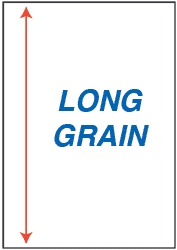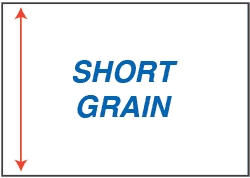Red River Paper products do not come with a grain direction guarantee unless specifically labeled. That said, they tend to be grain long because of how we produce items from the master roll. However, we cut for best yield and minimal waste. This means that at times some inventory can switch grain direction. We do not track changes because grain direction is not guaranteed.
Papers Available as Grain Specific
50lb. Arctic Polar Luster Double-sided
60lb. Polar Matte Double-sided
50lb. Premium Matte Double-sided
What is Grain Direction?
A paper's grain is the direction in which most of the fibers lie. Grain is determined during the papermaking process, when fibers tend to align in one direction or the other. Paper can be identified as either grain short (grain is parallel to paper's short side) or grain long (grain is parallel to the paper's long side), depending on how the paper is cut.


Should I Care About Grain Direction?
The primary people who need to be concerned about grain direction are those making books. More specifically, people making books that are bound so that the spine holds the book together AND the paper needs to be folded as the book closes.
For books that use comb binding, wire binding, three-ring binding, and similar methods, grain direction is irrelevant.
In addition, if you plan to fold your paper for any reason, knowing the grain direction can be helpful so that the paper lies as flat as possible when folded. Will terrible things happen if you fold against the grain? No. It is a nice thing to know and use but folding with the grain is certainly not a requirement.
What Does Grain Direction Have to Do with Folding Paper?
For the easiest folding, and a fold that allows a book to stay open without springing closed, you want the fold line to run parallel with the grain direction.
What About Paper Weight? Does that Make Any Difference?
It does. Heavy and thick paper will be cumbersome to fold regardless of grain direction. Lighter and thinner papers fold easier and grain direction will be important in book binding situations. See above.
Related Posts and Information
Last updated: April 12, 2024




